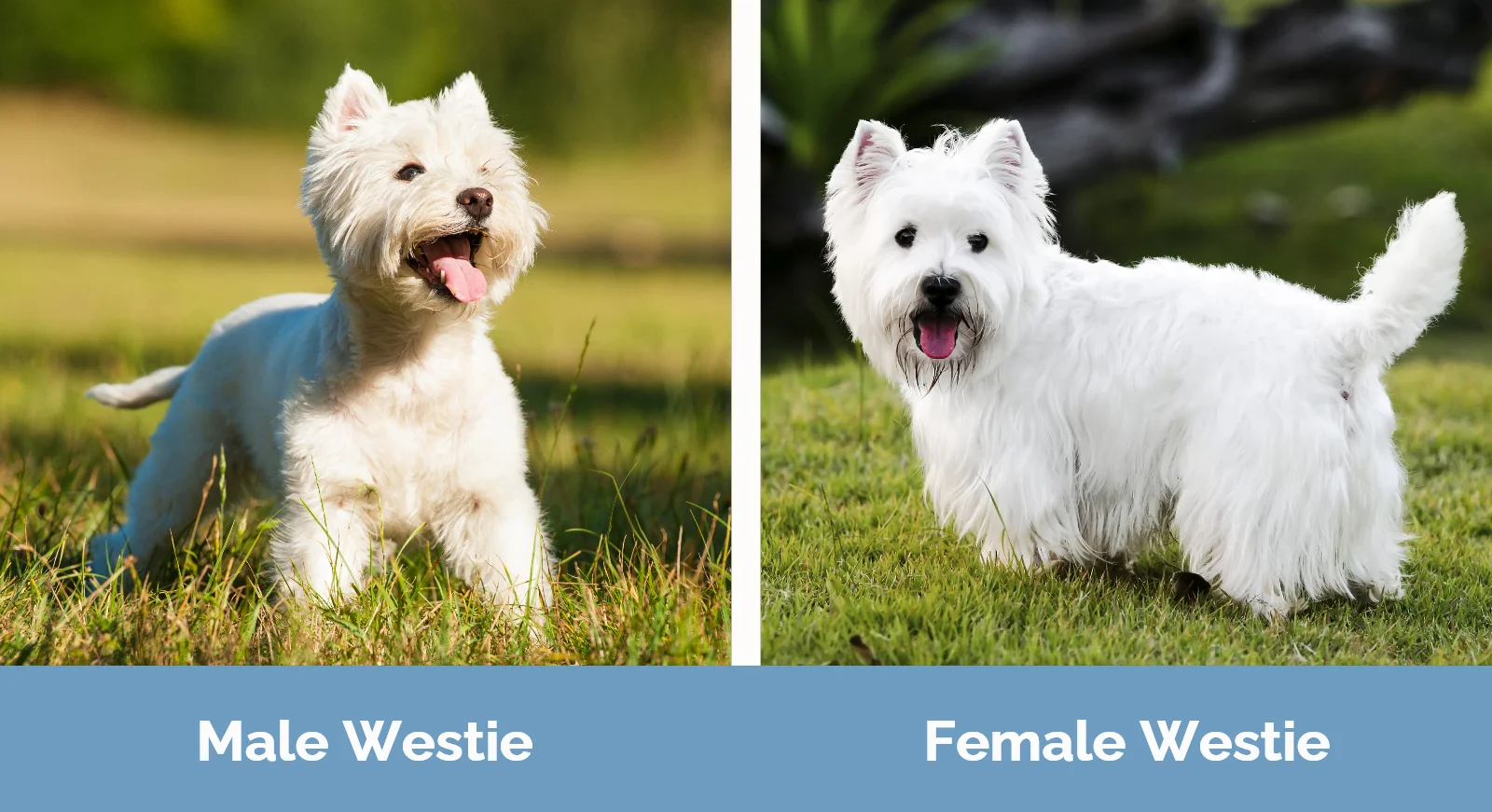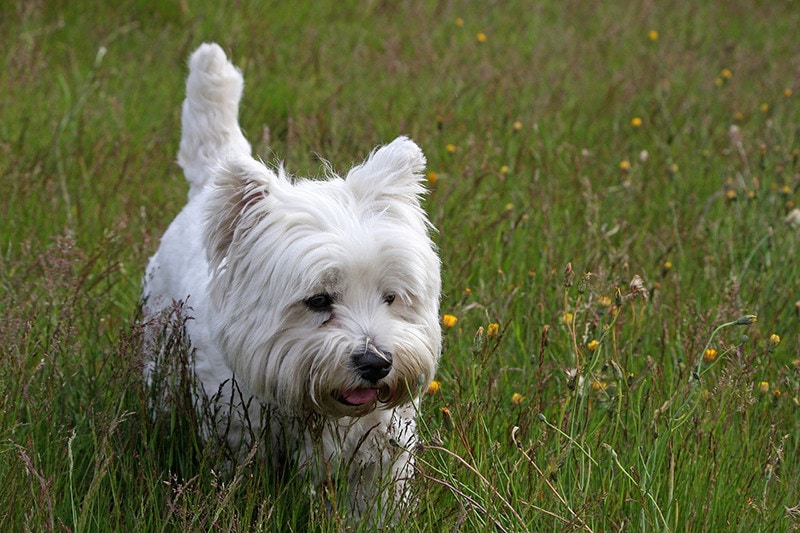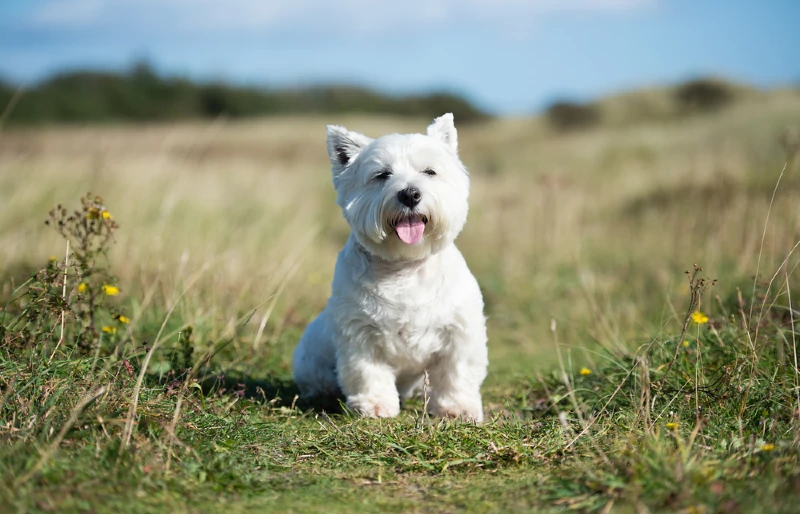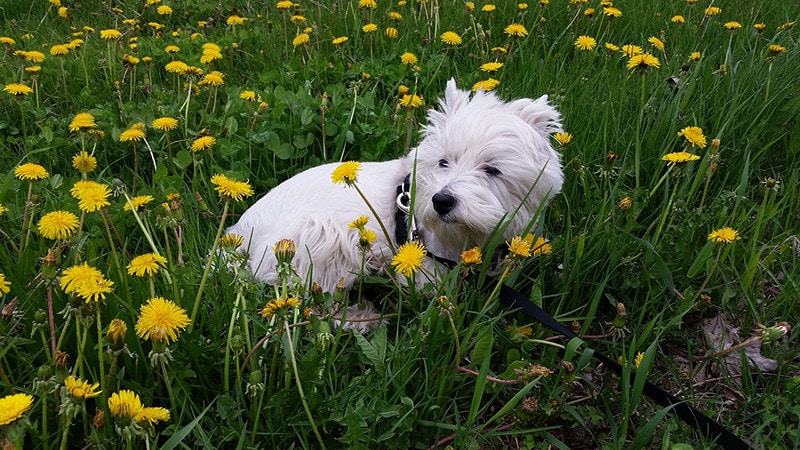Male vs Female Westie (West Highland White Terrier): Differences Explained with Pictures
By Kit Copson
Updated on

Click to Skip Ahead
Westies are good-natured and sturdy little dogs popular for their peppy personalities and adaptability. Some people like to consider gender-based differences when making a decision as to whether a male or female dog would be best for them, but most of these differences are purely biological. All dogs have their own personalities, and gender doesn’t guarantee anything in this regard.
Nevertheless, in this post, we’ll share some generalizations about male and female Westie dogs’ personalities, physical differences in terms of size, and the facts about hormonal behaviors linked to intact (unspayed or unneutered) dogs.
Visual Differences

At a Glance
- Average height (adult): 11 inches
- Average weight (adult): 15–20 pounds
- Average height (adult): 10 inches
- Average weight (adult): 15–20 pounds
Westie 101
The West Highland White Terrier, often shortened to simply “Westie”, is a small dog of Scottish origin, most likely related to Scottish, Skye, Cairn, Dinmont, and Dandie Terriers. They were originally developed as land hunters in the 18th century by the Malcolm clan, though it’s possible that the Westie’s ancestors were around during the rule of King James I. These dogs spent much of their time on estates and farms hunting down and exterminating rats.
The Westie we know today is a dog that can grow up to 11 inches tall, and has a medium-length, shaggy, white double coat, small, wide-set ears, and dark eyes. They’re small in stature but are nevertheless sturdy, hardworking, confident characters with a real “can-do” attitude.
Though not the kind of dogs to lounge about all day being pampered, Westies make affectionate and loyal family companions and are currently the 45th most popular dogs in the U.S. according to the American Kennel Club’s breed popularity ranking.
Male Westie Overview

Personality
We checked out what male Westie owners have to say about their personalities. Many have reported that male Westies are often very affectionate, friendly dogs that love to snuggle with their humans, but that they sometimes come with a hint of stubbornness. This seems to be a common trait among all Westies and is likely linked to their natural independence and assertiveness.
Please remember that these are just generalizations—whether male or female, your Westie will have their own, unique personality that can’t be predicted. You have to get to know them to find out.
Training
Westies of both genders are very intelligent and trainable, but they are also famous for being strong-willed, so you’ll need to be patient and consistent with them and match their confidence level.
Your Westie’s gender shouldn’t affect their training or learning capacity, though male dogs typically mature a bit more slowly than females do, so you might need to spend a little more time perfecting things with a male. There’s absolutely no guarantee that this will be the case, though.

Health & Care
Westies have been linked to breed-related health conditions, including allergies, orthopedic conditions, white shaker dog syndrome, pulmonary fibrosis, and digestive issues. Unneutered male Westies are at risk of developing conditions like testicular cancer and prostate gland diseases. Neutering can eliminate the risk of testicular cancer and certain prostate conditions.
Furthermore, unneutered male dogs looking to find a mate can be quite challenging in the behavior department. Unsavory behaviors sometimes displayed by unneutered male dogs include roaming, urine marking, mounting, humping, fighting with other dogs, and being more territorial than usual.
Breeding
If you decide to purchase a male Westie from a breeder, you should avoid inexperienced breeders and “backyard breeders”. Only experienced and reputable breeders that perform proper health screenings and have solid welfare standards should be considered. You may also be able to find male Westies in dog shelters in need of a new home, so that’s definitely worth looking into.
- Typically friendly and affectionate
- Trainable and intelligent
- Can be challenging when unneutered
- Might mature less quickly than a female
Female Pet Breed Overview

Personality
Female Westie parents tend to describe them as very sweet and loving, as is the case with male Westies. They can also be independent and spunky—it really depends on the dog and their upbringing and environment more than it depends on gender. We recommend spending some time with your potential new puppy or adopted adult dog before you make your decision to see how well you “gel”.
Training
Since female dogs tend to mature more quickly, this may mean that some females pick up new commands and respond to training efforts a little faster than males. Again, this is not a guarantee. Whether you get a male or female Westie, you can certainly expect a bit of sass to be thrown your way! Stubbornness is a well-known Westie breed trait, but this can be overcome by a kind but firm leader.

Health & Care
Female Westies have the potential to develop the same breed-specific conditions (and potentially other conditions in general) as male Westies, but unspayed females are vulnerable to breast cancer and uterine infections like Pyometra. Spaying can also help prevent hormonal behaviors related to the heat cycle, like roaming, yowling, and urinating more regularly than usual.
Breeding
Female dogs used for breeding can suffer from a variety of heat and breeding-related health conditions and problems, including uterine infections, inflammation of the uterus, and mastitis. Some experience other pregnancy and birthing issues, like false pregnancies and dystocia (difficult birth).
Furthermore, when irresponsible breeding occurs, future dogs are at risk of some serious genetic health conditions, which is why it’s best to adopt a Westie in need or at least acquire one from a respected and trustworthy breeder.
- Typically affectionate and playful
- May mature more quickly than males
- Unspayed females are prone to various health issues
- Unspayed females can display behavioral changes
Which Gender Is Right for You?
Our advice is to never pick a dog based only on whether they’re male or female. Instead, make your decision based on how well you “click” with that dog and whether you think you’ll be a good match for one another.
Though there are some anatomical differences between males and females and certain behaviors can occur in unneutered or unspayed dogs, both male and female Westies have equal potential to be the perfect companions.
Featured Image Credit: Left – No-longer-here, Pixabay | Right – chriskeller, Pixabay














